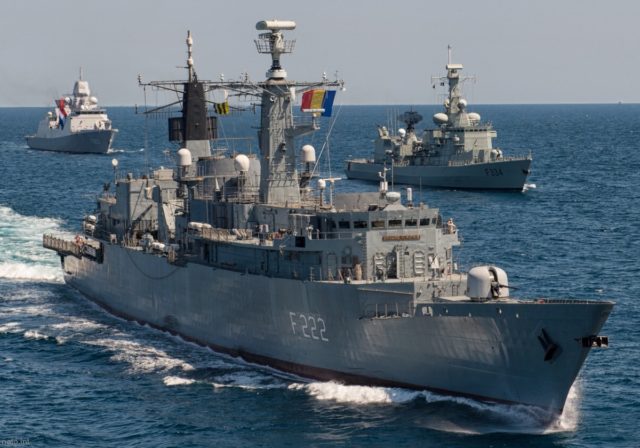
The Romanian Corvette Program Saga (Part One)
Publication: Eurasia Daily Monitor Volume: 18 Issue: 23
By:

In November 2016, the Romanian government decided to begin the first national warship-building program since the fall of Communism in 1989. More than four years have passed since this decision was been made, but no ships have been laid yet. The program for building four multi-role corvettes was designed to restart military shipbuilding in the country and to re-capitalize the Romanian Naval Forces, whose vessel inventory is made up of old and obsolete surface combatants. Politics and administrative mishandling of the program have seriously delayed the procurement and entangled it in a web of litigation for the past two years.
Of all the branches of the Romanian Armed Forces, the Romanian Naval Forces seemed uniquely affected by procurement delays. The Land Forces and the Air Forces have experienced postponements when it comes to acquiring new equipment, but gradually their programs have been put back on track. Furthermore, the Romanian Naval Forces have a negative track record when it comes to big-ticket programs. The best example is the long-delayed modernization of the two former Royal Navy Type 22 frigates, which were the subject of two previous failed tenders in 2009 and 2014, respectively (RNHS, March 20, 2020). Some naval programs have not been affected by delays and are currently on schedule, such as the modernization of the river monitors and of the armored patrol gunboats (see EDM, April 6, 14, 2020); but these represent the exception rather than the rule when it comes to naval acquisitions.
The technocratic cabinet led by then–prime minister Dacian Cioloș decided to pursue the multi-role corvette program through a direct award to Damen Galați (Hotnews.ro, November 26, 2016) a Romanian shipyard owned by the Dutch company Damen Group. The cabinet approved HG 906/2016 on November 29, 2016, which laid down the reasons for the procurement and the legal framework (Legislatie.just.ro, December 26, 2016). Damen Galați was selected as the main contractor because of its experience in building military vessels for the export market over the past 20 years. The SIGMA 10514 multi-role corvette designed by Damen was chosen to equip the Romanian Naval Forces. Four ships were contracted to be built and commissioned within seven years after the contract was signed. The first ship should have been delivered in three years and the remaining three in four years’ time. As part of the offset agreement, Damen also had to modernize the two Type 22 frigates and had to create a local maintenance and training facility. The Romanian government estimated the maximum cost of the program at €1.6 billion ($1.9 billion).
In December 2016, Romania held general elections and a new majority, led by the Social Democratic Party (PSD), was formed. Politics intervened and the corvette program was canceled. The new cabinet, headed by Sorin Grindeanu, decided to terminate the program, citing the failure of the previous government to secure parliamentary approval for it (Gândul, March 17, 2017). In Romania, any defense procurement program over €100 million ($121 million) needs approval from the legislature. However, HG 906/2016 was not a contract, but a procurement procedure. Damen Galați was not given the contract; rather, it was selected as a privileged partner of the Romanian government in this program. Moreover, the parliament needed to approve the program before any negotiation took place. In order to receive the contract, Damen had to pass three preliminary stages: a qualification stage, a negotiation stage and the final evaluation.
Why did the new government cancel the program? First, politically, the PSD-led government wanted to distance itself from the previous caretaker and technocratic cabinet, which had center-right leanings. Canceling a defense program adopted just before the general elections proved that a new cabinet with a new set of priorities was in charge. Second, the previous government may have miscalculated what would be the reaction of the local and international shipbuilders, which had business interests in the country. Romania would have been the first North Atlantic Treaty Organization (NATO) country to order the SIGMA-class vessel, while other European shipbuilders wanted to have a chance at providing a NATO navy with their own corvettes. Furthermore, the program included the modernization of the Type 22 frigates, which meant that Damen would have had the opportunity to work on six ships over seven years. That is a lot of work for single shipbuilder in a country that has another four large naval shipyards also looking for contracts. It is likely that Grindeanu’s new cabinet was lobbied by international and local shipbuilders to have the program awarded through a competitive acquisition process.
The corvette program was not altogether abandoned by the Romanian authorities. In 2017, it was included in the defense procurement package worth €9.3 billion ($11.3 billion), adopted by the parliament (Hotnews.ro, April 11, 2017). Despite the change of governments, the program was still valued at €1.6 billion. In 2018, a new PSD-led cabinet, this time chaired by Mihai Tudose, adopted HG 48/2018, which restarted the corvette procurement program (Gov.ro, February 15, 2018). The program would be awarded this time through a competitive process open to all local and international shipbuilders (from NATO and European Union member states) that fulfilled the conditions laid out by the Romanian government. The new procurement procedure also had three stages: a qualification stage, a competitive dialogue stage and an evaluation of offers stage. The winner of the tender was decided based on the last two stages, the criteria being the optimal offer with the smallest cost. Finally, the conditions for fulfilling the contract were the same as those laid down for the program in 2016: four ships built locally and delivered in seven years. The offset obligations were also the same as those in 2016: the upgrade of the Type 22 frigates and the creation of a training and maintenance facility. Yet the new tender process would prove as contentious and delay-prone as the previous ones.



